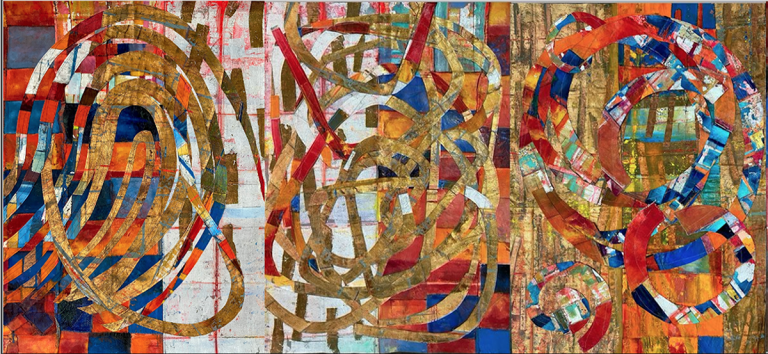Miguel Barros, born in Lisbon in 1962, is an artist with deep roots in Portugal, Canada, and Angola. His creative journey spans continents, and his work reflects the richness of these diverse cultural experiences. Barros graduated from IADE Lisbon in 1984, earning a degree in Architecture and Design, and this architectural background continues to inform his artistic approach. In 2014, Barros relocated from Angola to Calgary, Alberta, where he further expanded his creative horizons. His background in design and architecture has become a vital part of his painting, blending structure and imagination in unique ways. Barros’ art stands at the intersection of his global experiences and his formal training, resulting in works that are both visually complex and emotionally resonant.

One of Barros’ standout pieces from 2024 is Kaleidoscope, a large-scale painting measuring 90 centimeters in height and stretching across an impressive 420 centimeters in width. Created using oil on canvas and mixed media, Kaleidoscope demonstrates Barros’ commitment to pushing the boundaries of traditional materials. The painting incorporates a range of techniques, including cut paintings and canvas, to achieve a sense of depth and complexity rarely seen in works of this scale.
Kaleidoscope is a study in layering, with different materials coming together to create a mesmerizing interplay of transparency and depth. The use of cut canvas reveals hidden layers beneath the surface, as though the painting itself is unfolding to expose secret worlds within. Barros meticulously applied each layer of paint and material, pressing and manipulating them to test the limits of their flexibility. This process gives the work a tactile, almost three-dimensional quality, inviting viewers to feel as though they could step into the scene and explore it firsthand.
At its core, Kaleidoscope is an exploration of revelation and concealment. The title itself serves as a metaphor for the visual experience Barros has created. Much like the kaleidoscope toy, the painting offers viewers a fragmented yet harmonious world, where shapes and colors shift and evolve depending on perspective. Light plays a crucial role in this transformation, with beams cutting through the canvas to illuminate some areas while leaving others cloaked in shadow. This dynamic interplay between light and dark heightens the sense of mystery, as if certain elements of the composition are solid and present, while others remain elusive, flickering at the edges of memory and consciousness.
The figures that emerge within the layers of Kaleidoscope are equally intriguing. Some are clearly defined, while others are only hinted at, suggesting a range of emotions and experiences that span from joy to fear, from desire to doubt. These forms appear almost dreamlike, existing both within the world of the painting and just beyond it, as if they are echoes or shadows from another realm. Barros’ use of translucent materials further enhances this effect, making the figures seem as though they might vanish if you look away.
Color plays a vital role in Kaleidoscope as well. Barros has crafted a rich palette that contrasts vibrant tones with softer, more muted shades, creating a balance between light and dark, transparency and opacity. This contrast evokes the feeling of looking into a mirror that reflects not only the external world but also the viewer’s inner thoughts and emotions. The painting becomes a space for contemplation, a place where the boundaries between reality and fantasy blur, and where past and present, dreams and fears, can coexist.
Perhaps the most striking element of Kaleidoscope is the way it evokes a sense of movement. Despite being a static painting, the composition feels alive with motion, as though the shapes and colors are shifting and transforming before the viewer’s eyes. This illusion of movement is heightened by the layering of materials and the subtle play of light across the surface, creating a constantly evolving visual experience. Kaleidoscope is a work that rewards careful observation, offering new discoveries with each viewing.
In this remarkable painting, Barros has succeeded in creating a world that is both familiar and mysterious. Kaleidoscope draws viewers into its layered depths, encouraging them to explore not only the physical space of the painting but also their own emotions, memories, and desires. It is a powerful example of how art can transcend its materials and become a reflection of the human experience. Through Kaleidoscope, Barros invites us into an enigmatic universe, where concealment and revelation play out in equal measure, much like the ever-shifting view through a kaleidoscope.

